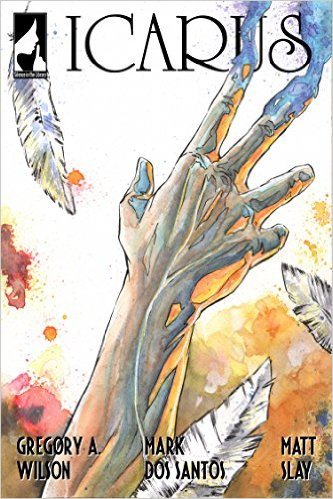
Gregory A. Wilson is a man who wears many hats. Not only is he a fantasy author, but he is a college professor, one of the hosts of the science fiction and fantasy podcast Speculate!, and a TwitchTV channel host! His latest endeavor as author is the upcoming graphic novel Icarus, an epic fantasy about a pair of unlikely heroes who are bound together by their quest to free an entire people from slavery. This week, Greg tells us what made him geek out while writing Icarus.

I am an unabashed Cirque du Soleil fanboy.
Completely. I’ve seen at least eight different touring shows in three different cities, bought the DVDs, the soundtracks, a hat for my kid. I even got a Cirque du Soleil branded water bottle, because it’s branded and therefore better sobequietokayitisawesome. I know this means I’ve totally fallen for the hype: these things aren’t cheap, and I mean, a water bottle… But even my typically careful nature seems to vanish when confronted with the prospect of a Cirque show.
Some of it certainly has to do with the astonishing athleticism and artistry of the Cirque productions; I defy anyone to watch a Cirque show and not be, at some level, mesmerized by the experience. This is spectacle par excellence. But I’ve seen other brilliant feats of acrobatics before. What sets Cirque apart is its understanding of visual narrative, how to represent a story with striking visual images which leave a lasting impression. And in my case, one such image was the spark for a project just about to begin its release. In their touring production Varekai, the no-longer doomed Icarus falls into a forest of strange creatures, whose reactions to him form the basis for the rest of the show. As usual, the whole experience was extraordinary, but that first moment–Icarus’s descent to the ground, his wings backlit by a blinding red-white light–was so stunning to me that the rest of the production was kind of a blur. My long-suffering wife was kind enough to drive home from the show as I furiously scribbled down notes for a new novel: Icarus, falling into the heart of a–forest? No, a volcano, a dormant volcano–on another planet–where he will meet a short, stocky, red-skinned…flamepetal prospector named Jellinek, who will sound like a character from the Old West, and…
And off I went. It took two years for me to write the novel Icarus, envisioning the world of Vol and the people the title character would meet when he landed there, and as might have been expected the book went in a different and more complex direction than I had thought it would when I first started. But the visual emphasis remained, and when Silence in the Library Publishing’s Ron Garner–a passionate comic book and graphic novel fan from childhood–and I began to chat about the possibilities for a graphic novel based on Icarus, I immediately imagined the way the world would look: the Salamander Kings in their lava pools, the Magister tower in the village of Vesu, the first sight of the city of Vius. And of course, the characters: Jellinek, his two-tailed, flamepetal-seeking solar Rig (a lava resistant creature partly inspired by my dog), and many others–and Icarus. It didn’t take me long to agree to the idea of turning Icarus into a graphic novel after that discussion.
When Matt Slay, one of the two artists for Icarus, started work on the cover art, I gave him my initial idea: Icarus’s fall, of course, the seemingly endless descent into the heart of Vol, looking something like Gandalf’s plunge into the heart of Middle-Earth while battling the Balrog. My idea had that image at a distance, an unknown third party watching from somewhere far away as Icarus makes his descent. “I can do that for the back cover, sure,” he replied. “But for the front cover, what about showing his arm as he falls? What about a close-up?”
I hadn’t even considered the possibility, but he was entirely right: bringing readers close to Icarus from the very beginning, before even opening the book, was going to have a powerful impact on their ultimate feelings about the character. It was also going to give me a chance to replicate, in a small way, my own experience watching Varekai, creating a sense of awe and wonder at Icarus’s journey toward whatever awaited him.
And that’s the real geek-out part of all of this. When–after a long and drawn out process, from conceiving the book in 2006 to finishing the manuscript in 2008 to beginning the Kickstarter run for the graphic novel in January 2014 to a two year cycle of art and approval concluding in early 2016–I found myself looking at the pages for the finished product in April, I was strangely moved. This wasn’t the first time I had been published, and certainly I had felt proud, inspired, excited each time I had held a new book in my hands. But as I flipped from page to page, looking at Matt Slay and Mark Dos Santos’s visions of the world of Vol, I was awestruck–not just by their art, which was extraordinary, but by the way the images which had been part of my imaginative field for so many years had somehow been transformed into a visually stunning work, one which others besides myself could now enjoy. My words, inspired by a visual image, had inspired an extraordinary set of visual images in turn. My eight year-old daughter, to whom I had dedicated the book when I finished it two weeks before her birth, looked over my shoulder as I looked at the screen: “Daddy,” she said, “that’s Icarus, isn’t it? Isn’t that Icarus falling?”
It was indeed. It was a long way from my seat at the production of Varekai which first fired my imagination, but it had been a journey well worth the effort. And if readers geek out about the book half as much as I do about Cirque du Soleil, I’ll feel very pleased. In the meantime, I already have tickets for the next Cirque show…and, of course, my branded water bottle is filled and ready to go.

About Icarus:
On the day Icarus falls into the volcano, everything in the world of Vol changes-above and below-for good. Icarus is a fair-skinned, blue-eyed young man with white wings and no memory; Jellinek is a four foot tall, red-skinned flamepetal prospector with little money and less patience. They are as different as night and day, sky and ground; but in the end, their differences will bind them together more strongly than either one could have predicted.


